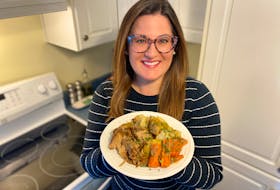The Gregorian calendar places Christmas Day on Dec. 25, the date when most Canadians celebrate. But Ukrainians and others whose roots are in the Orthrodox churches follow the Julian calendar. For them, Christmas falls on Jan. 7.
I have been learning some of the Ukrainian Christmas traditions from a Ukrainian-Canadian friend. Similar customs, reflecting their agricultural economies and religious beliefs, are followed in neighbouring countries such as Poland.
For Ukrainians, an important part of the observance takes place on Christmas Eve (Svyat Vechir), Jan. 6. At the end of a day of fasting — only light snacking allowed — to commemorate the difficult journey of Mary travelling to Bethlehem, families gather to share a traditional supper, Sviata Vechera. An extra place may be set at the table, in memory of recently deceased family members, and a candle is placed in the window as an invitation to a homeless stranger or a lost soul.
Much of what happens at the Christmas Eve table is prescribed by tradition. A handful of hay is placed on the dining table to symbolize the manger and is covered by a fancy embroidered tablecloth. For a centrepiece, three circular breads, called kollach or kalach, are stacked one on top of the other, encircling a candle. The symbolism of the trinity, eternity and prosperity is both religious and secular. The children must watch for the first star in the eastern sky, the signal that the meal may begin. After the patriarch of the family brings a sheath of wheat to the dining room, symbolizing the gathering of the clan, and offers a traditional greeting, the family prays and the meal begins.
Dinner consists of 12 dishes, representing the 12 apostles. There are many traditional Christmas Eve dishes, some of them served at every Sviata Vechera. Everyone present is expected to eat some, even just a small taste, of each dish. No meat, animal fat, milk or milk products can be included in this meatless meal, but fish is served.
The first dish, always, is Kutya, made from cooked wheat combined with honey, ground poppy seed, and sometimes chopped nuts. It’s often eaten from a common dish, and in some families, a spoonful is thrown at the ceiling. If it sticks, it predicts a good harvest in the coming year. My friend remembers seeing her aunt peeling Kutya from the ceiling after one of these Christmas Eve meals.
Next may come pickled dishes, such as pickled herring or mushrooms or borsch, beet soup, made without meat or meat stock for this occasion.
Some of the fish dishes that might follow are fish balls or patties, coated in crumbs and browned in fat, fish in aspic or baked stuffed fish.
Pyrohy or Vernyky (what I would call perogies), with fillings of potato and onion, or with sauerkraut, are made without cheese, bacon fat or butter for the meatless Christmas Eve meal. Likewise, the Holubsti (cabbage rolls) are made without meat for this occasion.
Beans, legumes and cabbage or sauerkraut all signify prosperity in the coming year. Kolochena Fasolia, mashed beans, is a natural for this meal, and a healthy economical dish that we might all incorporate into winter meals. Here is a recipe.
Kolochena Fasolia
- Mashed Beans
Adapted from Ukrainian Traditional and Modern Cuisine, Ukrainian Catholic Women’s League of Canada, Eparchy of New Westminster.
500 mL (2 cups) white navy beans
1 large onion, chopped
50 mL (¼ cup) oil
2 cloves garlic
salt and pepper to taste
Rinse beans and soak overnight. Drain ad add fresh water to cover, and simmer slowly for about 2 ½ hours. Drain and mash. Saute onion in oil; add to beans. Stir in garlic, salt and pepper. Serve hot.
Here’s another dish that might fit well into our Canadian winter menus. When using this recipe on Christmas Eve, the cook would omit the salt pork and sour cream, and use cooking oil for the fat.
Sauerkraut with Peas
Adapted from Stechishin, Savella: Traditional Ukrainian Cookery, Trident Press Ltd., Winnipeg, 1991.
750 mL (3 cups) sauerkraut
150 mL (2/3 cup) water
100 g (¼ lb) salt pork or bacon, chopped
1 medium onion, chopped
25 mL (2 tbsp) flour
25 mL (2 tbsp) sour cream
250 mL (1 cup) cooked dried peas
125 mL (½ cup) cooked mushrooms
Half clove garlic, crushed, if desired
salt and pepper
Taste the sauerkraut for acidity. If necessary, rinse in warm water once or more and drain it. Cook the sauerkraut, uncovered, in the water for about 15 minutes. In another pan, cook the salt pork or bacon until crisp, remove from the fat and reserve it.
Add the onion to the fat in the pan and cook until it is tender. Sprinkle the flour over the onion and brown very lightly. Pour in the liquid from the cooked kraut and cook, stirring constantly, until thickened. Combine this sauce with the sauerkraut along with the remaining ingredients and the reserved salt pork or bacon. Simmer this mixture for about 20 minutes to blend the flavours. It should be quite thick. Serve as a vegetable with any preparation of pork.
Dessert on Christmas Eve may be Honey Cake (Medivnyk), or a compote of dried fruit.
By exploring the traditions of many cultures, as I plan to do throughout the year, we can enrich our own mealtimes.
Margaret Prouse, a home economist, can be reached at RR#2, North Wiltshire, P.E.I., C0A 1Y0, or by email at [email protected].








